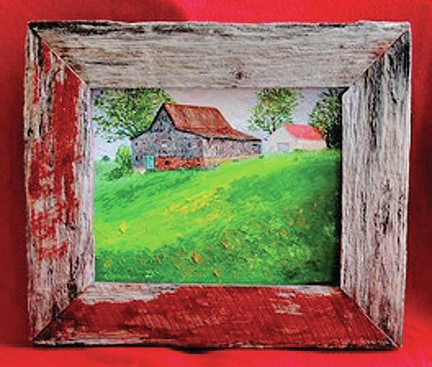
Editor’s Note – This is the third in a series of stories authored by Robert Kroeger, who has painted 11 barns in Highland County and has plans to paint more. The first 11 paintings, usually framed with actual wood from the barn pictured, will be auctioned off April 2 when the Highland County Extension Support Committee holds its annual dinner fundraiser at the fairgrounds. Proceeds from five of the paintings will benefit the committee. Kroeger titled this story, “No Strangers Here Today.”
A gray, stone marker near the top of the farmhouse that sits next to this old Highland County barn, reads: R & E Edwards 1852. When its current owners, Diana and Doug McKay, bought the property, they had to decide whether or not to restore it. Well aware of the barn’s story, they chose to restore, spent many hours and dollars in a major clean-up, earning blisters from removing the many vines of poison ivy that had engulfed the house.
Under old carpet they found perfectly preserved inlaid wood floors, their elaborate hexagonal pattern showing the carpentry skills of 19th century builders. They discovered that the stone marker referred to the original owners, Robert and Elizabeth Edwards.
Robert Edwards married Elizabeth in 1832 and built this house 20 years later. They may have erected the barn before the house, as often happened – since the barn represented income and survival. They were Quakers, Protestants who were known for their abolitionist views. And, as other families did throughout Ohio, they opened their doors to slaves traveling along the Underground Railroad. Today, the road in front of this farm is named Underground Road. It’s located between Leesburg and Highland.
Diana and Doug took us into the kitchen and showed us a trap door, which was originally located outside the house, where the slaves would slide down into a cistern that led to a small room where they would hide until it was safe for them to leave. Diana and Doug preserved the trap door by building a porch over it.
Even though Ohio was a free state, it was legal for slave hunters to find escaped slaves and take them back to their owners. And, there were penalties for those who harbored slaves. So, it was important for abolitionists to keep a low profile.
Move forward in time to 2008, 150 years later. Susan Banyas of Portland, Oregon, great-great-granddaughter of Elizabeth Edwards, was rummaging through the attic and found a diary that Elizabeth had written during the days when they harbored slaves. One entry from the diary grabbed Susan’s attention: “January 1, 1864, I arose this morning twelve minutes after five, found it middling cold, thermometer 10 degrees below zero, blowing strong. No Strangers here, but Adeline sewing at Maria’s dress. Men sitting around. Too cold to work.”
Stunned by this discovery, Susan read the diary and noted the phrase that frequently appeared, “No strangers here today.” In other words, no slaves came today. Elizabeth wisely avoided writing “slaves” in case the diary would be found by slave hunters.
Touched by the diary and this phrase, Susan wrote a play, “No Strangers Here Today,” and contacted a jazz composer in California. Together, they produced the play and toured the country.
Did the slaves also hide in the barn? Maybe. Unfortunately, this old beauty will be torn down – restoration would cost $60,000, which doesn’t make any economic sense. Its hand-hewn beams, mortise and tenon joints, and wooden nails testify that the builders knew which woods to use. But its siding has warped, its foundation is cracking, and Father Time has caught up with it. Personally, I like its colors: a mottled pale blue door, the rusted red roof, and grayish-red side boards. The builders placed it directly into a bank so that they didn’t have to move dirt to create the bank. It was used for dairy cows.
So, let us never forget this old barn, even though it will come down someday, its story of fugitive slaves, and the Quaker family who cared for them. Thanks go to the McKays for preserving the historic farmhouse and for providing some of the barn’s own wood to frame the painting.
For more information visit www.barnart.weebly.com.
Robert Kroeger is a former Cincinnati area dentist who has since competed in and organized marathons, taken up the painting skills he first picked up from his commercial artist father, become a published author, and is a certified personal trainer who started the LifeNuts vitality program.


